
The House of Orange-Nassau is the current reigning house of the Netherlands. A branch of the European House of Nassau, the house has played a central role in the politics and government of the Netherlands and Europe especially since William the Silent organised the Dutch Revolt against Spanish rule, which after the Eighty Years' War (1568–1648) led to an independent Dutch state.

The Most Excellent Order of the British Empire is a British order of chivalry, rewarding contributions to the arts and sciences, work with charitable and welfare organisations, and public service outside the civil service. It was established on 4 June 1917 by King George V and comprises five classes across both civil and military divisions, the most senior two of which make the recipient either a knight if male or dame if female. There is also the related British Empire Medal, whose recipients are affiliated with, but not members of the order.

Prince of Orange is a title originally associated with the sovereign Principality of Orange, in what is now southern France and subsequently held by sovereigns in the Netherlands.

The Order of the White Eagle is Poland's highest order awarded to both civilians and the military for their merits. It was officially instituted on 1 November 1705 by king Augustus II the Strong of Poland and elector of Saxony and bestowed on eight of his closest diplomatic and political supporters. It is one of the oldest distinctions in the world still in use.

The Military William Order, or often named Military Order of William, is the oldest and highest honour of the Kingdom of the Netherlands. It is named after St. William of Gellone (755–814), the first Prince of Orange. Its motto is Voor Moed, Beleid en Trouw. The chivalric order was established on 30 April 1815 by King William I and was presented for feats of excellent bravery on the battlefield and as a meritorious decoration to senior military officers. Comparable with the French Légion d’Honneur but far less often awarded, it is open to everyone regardless of rank or nobility—not only to Dutch military, but also to foreigners. To date, membership in the Order is extremely rarely awarded, and only for exceptional bravery in battle.

The Order of Orange-Nassau is a civil and military Dutch order of chivalry founded on 4 April 1892 by the Queen regent Emma, acting on behalf of her under-age daughter Queen Wilhelmina.
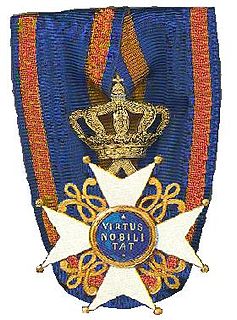
The Order of the Netherlands Lion, also known as the Order of the Lion of the Netherlands is a Dutch order of chivalry founded by King William I of the Netherlands on 29 September 1815.
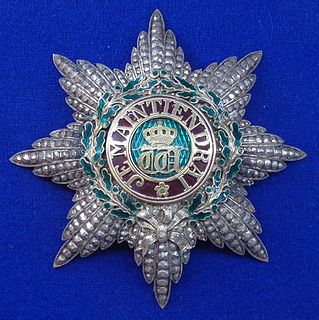
The Order of the Oak Crown is an order of the Grand Duchy of Luxembourg.

The flags of the Dutch royal family are a set of flags used to identify a member of the royal family. The current system of flags for the Dutch monarch, princes, and princesses was introduced in 1908.

Pro Ecclesia et Pontifice is a decoration of the Holy See. It is currently conferred for distinguished service to the Catholic Church by lay people and clergy.
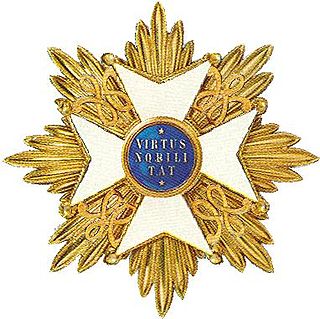
In the Dutch honours system, most orders are the responsibility of ministers of the Netherlands Government. The house orders, however, are awarded at the discretion of the Dutch monarch alone.

The 1914 – 1918 Fire Cross was a Belgian military decoration awarded to all holders of the so-called "Fire Card" which was awarded to all who came under fire at the front during the First World War. The medal was established by royal decree on 6 February 1934. It could not be awarded posthumously.

The Gelre Armorial is a medieval armorial.

The Honorary Order of the Palm is a military and civil state decoration of the Republic of Suriname. The Order was instituted in 1975 at the independence of Suriname and replaced the Dutch Order of Orange-Nassau. It is awarded to individuals for special service in the civil or military field. The order is also eligible for foreigners. The president of Suriname is the Grand Master of the order.

The Resistance Memorial Cross or Resistance Commemorative Cross is a medal awarded in the Netherlands to members of the Dutch resistance during the Second World War.

The Deportees' Cross 1914–1918 was a Belgian war medal established on 27 November 1922 by royal decree and awarded to Belgian citizens deported to Germany for forced labour during the First World War.

The Düppel Storm Cross was a military medal of the Kingdom of Prussia. The cross was awarded to Prussian participants in the Battle of Dybbøl which took place on 18 April 1864, during the Second Schleswig War. Established by Wilhelm, King of Prussia on 18 October 1864, the cross was initially awarded to combatants and noncombatants who directly participated in the battle. The following year, versions were created for those troops held in reserve at the battle and members of the Johanniter Orden who participated in the battle.

In the Colonies and Boer Republics which became the Union of South Africa in 1910, several unofficial military decorations and medals were instituted and awarded during the nineteenth and early twentieth century. The Johannesburg Vrijwilliger Corps Medal is an unofficial private campaign medal which was instituted in 1899 by Lieutenant Colonel S.H. van Diggelen, the founder and Commanding Officer of the Johannesburg Vrijwilliger Corps, for award to the officers and men of his unit.
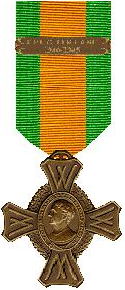
The War Commemorative Cross is a military award of the Netherlands. The medal was established to commemorate service to the Kingdom of the Netherlands during World War II. The medal was established on 16 March 1944 by royal decree of Queen Wilhelmina.
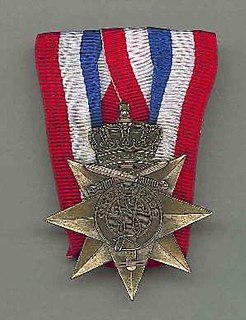
The Decoration for Order and Peace is a military award of the Netherlands. The medal was established on 12 December 1947 by royal decree of Queen Wilhelmina. The medal commemorates at least three months of service in the Dutch East Indies and adjacent waters during the Indonesian National Revolution. It was awarded to members of the Netherlands Armed Forces and the Royal Netherlands East Indies Army. Recipients who were engaged with hostile parties in a military context could be awarded clasps indicating the year of the action.





















